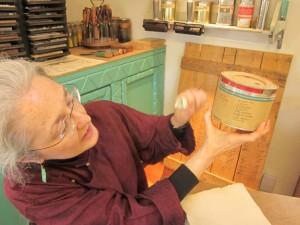 Excerpts from CNET by Daniel Terdiman:
Excerpts from CNET by Daniel Terdiman:
At Getty Museum, revelations of art via tech. Known for its collection of classic European art, the Getty Museum in L.A. uses technology to enhance visitors’ experiences and to study its masterpieces. CNET Road Trip 2012 stopped by…
While visitors will use their mobile devices to learn more about the artworks they encounter at the Getty, they’re also being encouraged to learn how the museum’s scientists use technology to study and maintain art there.
This is currently being showcased in the presentation of Dutch artist Maerten Van Heemskerck’s 1544 triptych “Ecce Homo,” which is on loan from the National Museum in Warsaw, Poland. Located in a special gallery at the Getty, “Ecce Homo” offers visitors the chance to see how conservators use technology like X-Rays, stratiradiography, infrared reflectography, and multispectral and hyperspectral imaging to examine every element of the masterpiece — the front, the back, and even below the paint.
X-rays, explained Yvonne Szafran, the Getty’s senior conservator of paintings, are useful because the technology can provide a glimpse of the structure of a painting, and how an artist applied paint to it. That works, Szafran explained, because the pigments in paint vary in their radio-opacity. So, for example, anywhere Heemskerck used lead white paint shows up in an X-ray as very dense. 
With stratiradiography, Szafran and her team can examine a painting at an angle while spinning it around in order to see if there are elements that have been obscured. For example, with “Ecce Homo,” she was able to determine that on the back side of the triptych’s left panel, Heemskerck had originally included a swan, and then painted over it.
By using infrared reflectography, Szafran explained, it’s possible to see just below the layer of paint, but not all the way to the wood below, something that’s particularly valuable in trying to see the artist’s original drawing. With “Ecce Homo,” Szafran said, it’s possible to see that the drawing below the painting was done with black chalk.
Conservators also use ultraviolet light to discover post-painting restoration, as well as to identify certain kinds of pigments.
Finally, Szafran and her colleagues can use multi-spectral imaging and hyper-spectral imaging to identify the different kinds of materials used in an artwork without having to take a sample.





 Titian’s portrait has had the good fortune over the centuries to be cleaned both regularly and carefully — “rather than being subjected to complicated and invasive restorations, the painting has instead been the object of constant maintenance,” Gabriella Incerpi writes in the exhibition catalog — and that meticulousness has made things easier for modern conservators, who seek the least obtrusive ways to strip away the dulling effects of decades of varnish and restore a painting’s original brightness and tones.
Titian’s portrait has had the good fortune over the centuries to be cleaned both regularly and carefully — “rather than being subjected to complicated and invasive restorations, the painting has instead been the object of constant maintenance,” Gabriella Incerpi writes in the exhibition catalog — and that meticulousness has made things easier for modern conservators, who seek the least obtrusive ways to strip away the dulling effects of decades of varnish and restore a painting’s original brightness and tones.
 r “borrowed” objects as structural elements. The shiny green bottoms of 7-Up bottles figure prominently here. And since Rodia was a tile cutter and setter, visitors will note several specimens from the Malibu Tile company, as well as numbered tiles that had once been catalog material. They’ll also encounter china fragments of every possible shape and color, sea shells, cooking utensils, mirror pieces and larger forms like mortar “gardens,” “the ship” and hearts fashioned out of concrete. There’s even a wall made of slag and frit, the raw materials for making glass.
r “borrowed” objects as structural elements. The shiny green bottoms of 7-Up bottles figure prominently here. And since Rodia was a tile cutter and setter, visitors will note several specimens from the Malibu Tile company, as well as numbered tiles that had once been catalog material. They’ll also encounter china fragments of every possible shape and color, sea shells, cooking utensils, mirror pieces and larger forms like mortar “gardens,” “the ship” and hearts fashioned out of concrete. There’s even a wall made of slag and frit, the raw materials for making glass.